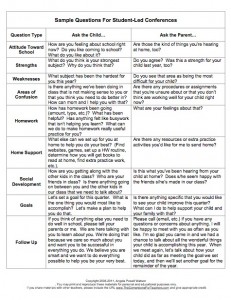This page shares a simple format for improving the quality of parent-teacher conferences: hold student-led conferences! Learn how to involve your students in reflecting on their work and sharing their progress with their families.
What are student-led conferences?
They are parent-teacher conferences in which the child is not only present, but in charge of explaining his or her progress, reflecting on accomplishments, and setting short and long-term goals.
Why should I do student-led conferences?
- show parents and students that their opinions and experiences are valued by the teacher
- empower the child to take responsibility for her learning
- give the parent and teacher a chance to hear the student reflect on his progress in his own words
- reassure students that parents and teacher are there to support them
- hold students accountable for their academic and behavioral choices
- give the parent the opportunity to see the teacher and child interact
- provide the teacher with insight about parent-child relationships/home structure
- take unnecessary pressure off of the teacher by focusing on the student and his/her work samples
Most importantly: because parents and students love doing them! Parent turn out at student-led conferences is often higher than traditional conferences because students are so vested in the process.
When should I do student-led conferences?
You should do what is best for you and your families. As a general suggestion for the first parent conference of the year, the student should be nearby in the room but out of earshot (reading in the library area of the classroom, etc.) so that the parents and teacher can speak privately but the child can still be involved as needed. I like to draw the child in toward the end as we wrap up.
In the first conference of the year, the parent primarily provides background information on the child and the teacher clarifies expectations and progress thus far. Later conferences can then be student-led, as often as once a quarter, with parent-teacher only conferences as needed.

What preparation do I need to do before the conferences?
Because students take responsibility for these conferences, they require very little work for the teacher. You only need to set up a class routine in which students are regularly selecting work for their portfolios.
There are lots of ways to do this. One easy way is to have the children select their best work each week from their Friday Folders (or whichever procedure you use for sending home graded papers) and write on a sticky note why they chose that paper. Have students keep their papers in date order in their portfolio (a hanging file, file folder, or even a clean pizza box–ask a pizzeria to donate a class set– if you have a lot of 3D or large work samples).
The day of the conference, the student pulls her portfolio and, ideally, practices presenting the papers to a buddy, to you, or to herself.
How do the conferences work?
I like to use this free printable student-led conference form to help me make sure I’ve hit all the important topics. Having a set of questions I want to ask makes the conference feel more collaborative than having a list of facts I want to tell the family.
At some point during the conference, the child shows his parent(s) his best work from the child-created portfolio and uses the sticky notes he attached to each work sample to help explain why he chose that assignment.
The child may also demonstrate how to solve a math problem that was challenging, read a passage to demonstrate a reading strategy, share a story she wrote and explain the writing process used, etc.
I use the student work as a springboard for discussion during the portfolio sharing and afterwards (however the conversation flows best.) As a general rule, I like to direct questions to the child first, and follow up with questions for the parent as appropriate.
The ideal interaction is fluid, casual, and focused on all 3 parties sharing their insights in a positive way. The child typically enjoys being the center of attention and parents appreciate being asked for their opinions. The teacher is able step down from the responsibility of imparting negative information and judgement about a child’s abilities and progress, and move into the role of guiding the family towards mutually-drawn conclusions through carefully selected questioning techniques, conversation, and the sharing of observations. Conferences generally last 20-60 minutes, depending on the level of interaction between the parent and child.
What questions should I ask?
You can download this free printable student-led conference form and use it as a checklist to guide your questioning. If the child and parent are talkative, you can let them direct the conversation. However, this may be the first time families have ever experienced a student-lef conference and they may want you to guide things. You can go right down the list of questions, starting with the question for the child and then asking the parent the corresponding question for each topic. After a few conferences, this flow will happen naturally and you won’t even need the form!
The child can share his or her best work when you ask about strengths. The conversation about weaknesses and areas of concern often comes up on it’s own after that.

Angela Watson
Founder and Writer
Sign up to get new Truth for Teachers articles in your inbox
Discussion
OR

Join our
community
of educators
If you are a teacher who is interested in contributing to the Truth for Teachers website, please click here for more information.

















We are implementing for the new school year.
I want tips to hold these as a student, not a teacher.
Where can I find that?